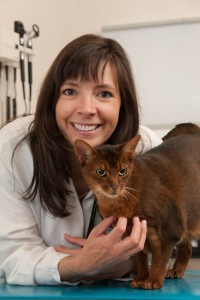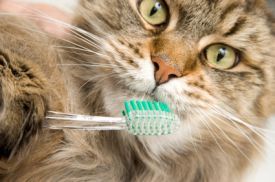Dental disease is one of the most common problems identified during an exam at the veterinary office.
Signs of dental disease, which pet owners may notice, include yellow or brown tartar build up, bad breath, difficulty chewing or bleeding from the gums after chewing. These are signs of bacteria and inflammation.
 To address this condition, your veterinarian will recommend a dental cleaning. Because our pets cannot understand what we are asking of them, it is impossible to perform a thorough oral exam or dental cleaning while the pet is awake.
To address this condition, your veterinarian will recommend a dental cleaning. Because our pets cannot understand what we are asking of them, it is impossible to perform a thorough oral exam or dental cleaning while the pet is awake.
Anesthesia is required for a proper dental cleaning for your pet. While your pet is under anesthesia, an ultrasonic, sonic or hand scaler will be used to clean all sides of the tooth, both above and below the gum line.
Preventing periodontal disease
Cleaning below the gum line is one of the most important steps of the procedure because this is where bacteria lurk, gradually breaking down the attachment between the tooth and the bone – the condition known as periodontal disease.
According to the American Veterinary Medical Association, periodontal disease is the most common clinical condition in cats and dogs even though it’s completely preventable. That’s significant because the condition can lead to tooth loss and can damage the heart, kidneys and other internal organs, negatively impacting overall pet health.
After cleaning with a scaler, the teeth are polished to smooth out microscopic scratches from the scaler.
Home dental care
Home dental care is recommended to help maintain oral health in between cleanings. This may involve brushing the teeth of your dog or cat, one of the most effective ways to maintain oral health; use of a chlorhexidine oral rinse; and possible dental diets, with textures that provide a cleansing effect.
For tips on brushing pet teeth, watch this AVMA video.
The need for anesthesia
We recommend that pet dental cleanings be performed with anesthesia. In fact, veterinarians must intubate and anesthetize pets for dental procedures – including cleanings – for their hospitals to earn or maintain accreditation from the American Animal Hospital Association (AAHA), according to a mandatory standard adopted in August 2013.
 “The guidelines state that general anesthesia with intubation is necessary to properly assess and treat the companion animal dental patient,” AAHA President Kate Knutson explained. “Because AAHA practices are expected to uphold the highest level of veterinary excellence, AAHA’s leadership felt it necessary to update this dental standard so that they reflect best practices outlined in the guidelines.”
“The guidelines state that general anesthesia with intubation is necessary to properly assess and treat the companion animal dental patient,” AAHA President Kate Knutson explained. “Because AAHA practices are expected to uphold the highest level of veterinary excellence, AAHA’s leadership felt it necessary to update this dental standard so that they reflect best practices outlined in the guidelines.”
Those of us at the Colorado State University Veterinary Teaching Hospital agree with the standard, in part because pets undergoing dental cleaning without anesthesia would move during scaling; scalers are sharp instruments, so an inadvertent poke would cause trauma and pain in the oral tissues.
Without anesthesia, the pocket below the gum line and the inside part of the tooth, closest to the tongue, could not be adequately cleaned; this would result in progression of dental disease, along with possible tooth loss and chronic pain.
Note that only licensed veterinarians, or technicians working under the direct supervision of licensed veterinarians, are legally permitted to perform pet dental services.
If you have questions about pet dental care, or the standards for that care, be sure to ask your veterinarian! Good oral health contributes to good overall health.
Dr. Camille Torres-Henderson is a veterinarian with the Community Practice service at Colorado State University’s James L. Voss Veterinary Teaching Hospital. Community Practice provides general care, wellness care and treatment for minor injuries and illnesses for pets.